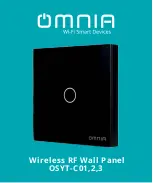
Section 2 – Radio Controlled Safety (Continued)
7
The operator should know procedures for testing hoist, trolley, and bridge brakes.
2-6.
Operating Area.
Aisles between equipment, stock, etc., should be free of obstructions so the crane operator can move freely. These
aisles should be a minimum of three feet (one meter) wide, or meet local regulations.
Crane operators should always position themselves for the best view of the crane they are controlling. The crane
should never be operated blindly. The operator should stay as close to the crane load as possible. Operators should
never position themselves in a "pinch" point.
2-7.
Transmitter Unit.
Transmitter switches should never be mechanically blocked ON or OFF for any crane motion. When not in use turn
the transmitter OFF. A secure storage space should be provided for the transmitter unit and the transmitter unit
should always be placed there when not in use. This precaution will prevent unauthorized people from operating the
crane.
Spare transmitters should be stored in a secure storage space and only removed from the storage space after the
current transmitter in use has been turned OFF, taken out of the service area and secured.
2-8.
Operating The Crane.
2-8.1.
Pre-operation Test.
At the start of each work shift, or when a new operator takes control of the crane, operators shall do as a minimum
the following steps before making lifts with any crane or hoist:
Test the upper-limit switch. Slowly raise the unloaded hook block until the limit switch trips. When checking limit
switches the hoist should be centered over an area free of personnel and equipment.
Visually inspect the hook, load lines, trolley, and bridge as much as possible from the operator's station; in most
instances, this will be the floor of the building.
The bridge and trolley brakes should be tested. On transmitter units equipped with two or more speeds, use the
"lowest" speed when testing braking devices.
When lifting maximum loads, the crane operator should test the hoist brakes by raising the load a few inches from
the floor. If the brakes do not hold, the load should immediately be lowered to the floor.
If provided, test the lower-limit switch.
Test all warning devices.
Test all direction and speed controls for both bridge and trolley travel.
Test all bridge and trolley limit switches, where provided, if operation will bring the equipment in close proximity to
the limit switches.
Test the transmitter emergency stop.
Test the hoist brake to verify there is no drift without a load.
If any crane or hoist fails any of the above tests notify the supervisor and lock out and tag for repair.










































